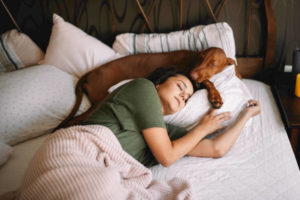 If you suffer from sleep apnea, a good night’s rest can be difficult. If you’re like many people in the US, you might sleep with your pet in your bed, which can also affect your sleep quality. With 65% of US households having pets, your sleep specialist may advise against leaving your furry companion in bed with you at night. Besides breathing disruptions, pets can also lead to poor sleep quality. Here’s how you can manage your sleep apnea symptoms without leaving your pet out of the room.
If you suffer from sleep apnea, a good night’s rest can be difficult. If you’re like many people in the US, you might sleep with your pet in your bed, which can also affect your sleep quality. With 65% of US households having pets, your sleep specialist may advise against leaving your furry companion in bed with you at night. Besides breathing disruptions, pets can also lead to poor sleep quality. Here’s how you can manage your sleep apnea symptoms without leaving your pet out of the room.
Pets and Sleep Quality
Owning a pet can provide a sense of security and relaxation; however, researchers have found that they can cause disruptive sleep if they are in your bed. Sleep apnea sufferers can already struggle to achieve adequate sleep from frequent breathing disruptions.
Obstructive sleep apnea causes pauses in breathing from the soft tissues in the back of your mouth and tongue blocking the airway. As your muscles relax, they can create an obstruction. Every time you stop breathing, it jolts your brain awake to resume normal respiratory functions. Although you may not be aware of these awakenings, they interrupt your sleep cycle.
Besides depleting your body of oxygen, poor sleep quality can also affect your physical and mental health. Over time, sleep deprivation can occur, which can lead to memory loss, mood changes, and poor cognitive abilities. You can be at risk of workplace and auto accidents from fatigue.
If your pet is close by at night, it can cause even more sleep problems. Whether you rely on your pet for companionship, a bed warmer, or safety, you may not want them to sleep in the bed with you.
Better Sleep is Possible
You don’t have to lock your pet out of your room to wake up feeling well-rested. Instead, sleep specialists recommend placing a bed for your pet on the floor instead of having them snuggle under the covers with you.
It’s also important to seek treatment for sleep apnea to stop breathing interruptions. You have multiple options to treat obstructive sleep apnea, including:
- CPAP: A CPAP machine is the most traditional treatment. It delivers a steady stream of air through a mask that’s worn over your mouth or nose to maintain oxygen levels in your body.
- Oral Appliance: As an alternative to a CPAP, an oral appliance can treat mild-to-moderate obstructive sleep apnea. The custom-fit device positions your tongue and jaw to keep your airway open to stop pauses in breathing.
With the right sleep environment and treatment, you can breathe better and rest peacefully to feel your best in the morning.
About Dr. Dean Hutto
Dr. Hutto graduated from the University of Texas Dental School and has regularly continued his education in various specialties, including sleep apnea. He is affiliated with several professional organizations, including the American Academy of Dental Sleep Medicine. Request an appointment through his website or call (281) 688-2104.
